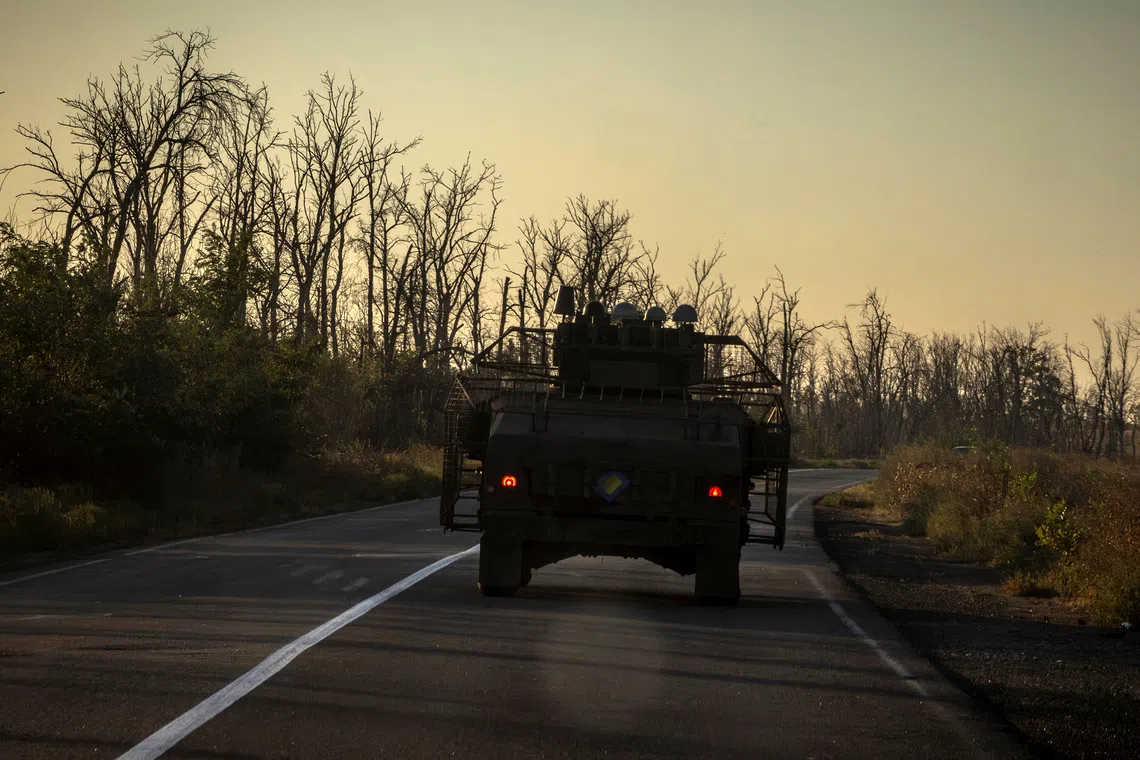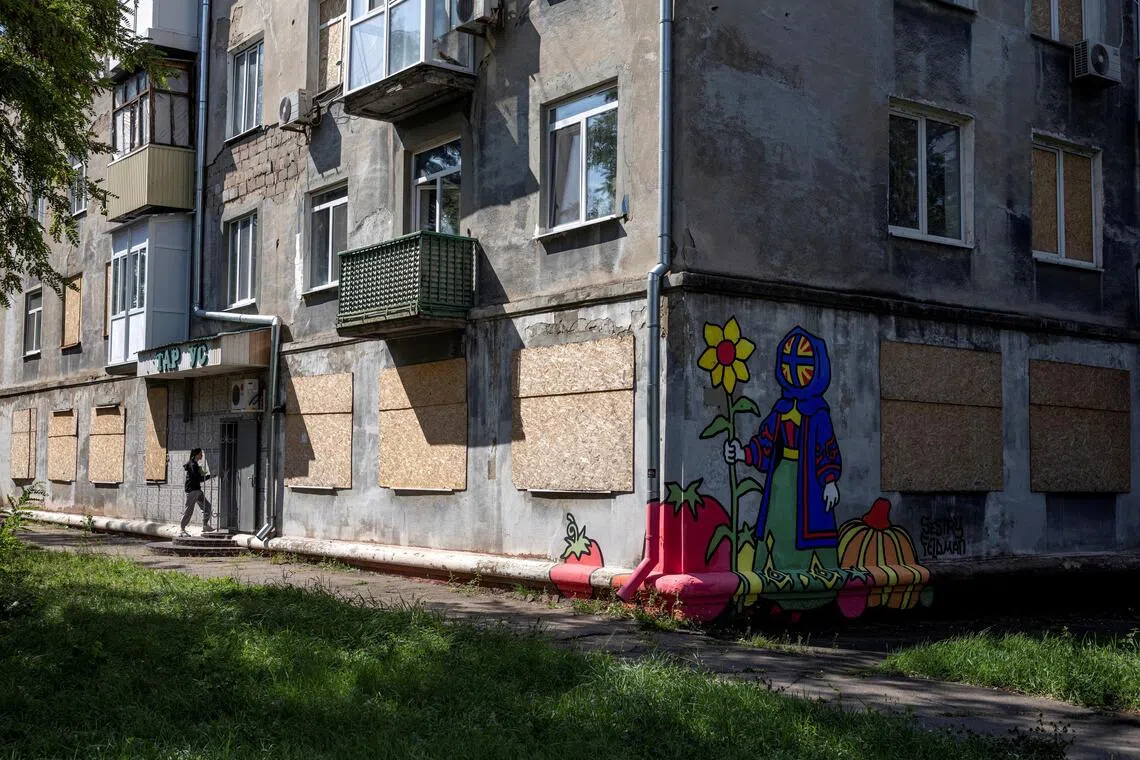Ukraine’s frontline cities filled with dread and defiance
Sign up now: Get ST's newsletters delivered to your inbox

An Ukrainian armoured vehicle with a protective anti-drone cage drives on a road outside Sloviansk, Ukraine.
PHOTO: REUTERS
Follow topic:
RAMATORSK, Ukraine - In his new clothes store in the heart of Ukraine’s frontline city of Kramatorsk, Mr Maksym Lysenko suddenly stops talking and listens.
“There,” he says, leaning towards the window looking onto the street. “It is going to dive. It is going to drop.”
Mr Lysenko, 29, had heard the high-pitched whine of a Russian suicide drone. Moments later, there is a loud explosion.
“Boom! This is Kramatorsk!” he says with a smile.
It is the third attack witnessed by Reuters in less than an hour by Russian drones terrorising the skies over one of Ukraine’s final bastions in the fiercely contested region of Donetsk.
Thousands of unmanned aerial vehicles hover above more than 1,000km of frontlines in Ukraine’s east and south at any one time, making even small infantry advances dangerous and costly.
The airborne threat extends to villages, towns and cities sucked into the strike zone, a belt of land 20km to 25km either side of the front line where fast and nimble remote-controlled first-person view (FPV) drones and other models fly.
As Russian troops grind westward in Donetsk, Kramatorsk is on edge.
Some parts of the city are less than 20km from Russian positions, and tens of thousands of people living there must decide whether they want to stay.
For Mr Lysenko, there is no question of leaving. He opened his Zaboy store on a pleasant, tree-lined street in June.
Barely flinching at the explosions, soldiers and civilians browse the racks of T-shirts and sweat tops, or buy a coffee at the bar.
The bright lights, pristine white walls and background music would not be out of place in a store in New York or Paris. On the wall behind the payment counter is a board covered in insignia badges donated by military units.

A shopkeeper, her face covered in dust after a Russian drone struck the roof of the indoor market in Kramatorsk, Ukraine, standing at the counter, refusing to leave.
PHOTO: REUTERS
“All of the T-shirts have the message – that we must be free from occupying forces,” Mr Lysenko says.
“For us, it is not just words, it is life.”
On the main city square, street cleaners sweep up the debris from a drone blast that damaged a car.
A covered market was also struck, causing damage and minor injuries.
One shopkeeper, her face still covered in dust from the blast, stands at her counter, refusing to leave.
Fortress belt under threat
Reuters spoke to three people who were in and around Kramatorsk and neighbouring Sloviansk for different reasons: Mr Lysenko for his shop, a farmer whose land lies west of the two cities, and a 25-year-old woman returning to the places she knew as a teenager.
“I started to feel like I have to be here because I would not forgive myself if I failed to see this place if it was to be occupied at some point,” says the woman, Ms Darka Harnyk, who works on the Energy Security Marshall Plan for Ukraine, which seeks to attract investment in energy infrastructure.
She travelled to Kramatorsk from Kyiv by train.
“As soon as I came out of the train, you could hear explosions, literally from the station,” she says, standing outside the boarded up “Vilna Khata” – or Free House – a community centre where she volunteered when she was 16.

Boards cover the ground floor windows of an apartment building to protect them from shrapnel in the frontline city of Kramatorsk, Ukraine.
PHOTO: REUTERS
All three of them rejected the idea of ceding territory to Russia in return for peace, as proposed by Russian President Vladimir Putin.
His main territorial ambition is to control all of Donbas, comprising the Donetsk and Luhansk regions.
Russia has occupied virtually all of Luhansk, and the Institute for the Study of War research group estimated that Ukraine holds only about 25 per cent of Donetsk as of Aug 7.
Kramatorsk and Sloviansk, both cities of around 200,000 people before the war now barely half that size, lie on what some call the “fortress belt” and are among the only viable major settlements still standing in Mr Putin’s way in Donetsk.
To the east lies Luhansk, south are the garrison towns of Kostiantynivka and Pokrovsk – all but surrounded by Russian forces – and looking west, there are mostly villages and fields.
Those fields include land managed by Mr Serhii Kurinnyi, director of the KramAgroSvit agricultural group, which includes a dairy plant and cattle farm.
Mr Kurinnyi, 61, whose family has worked the land for generations, does not think Mr Putin would stop at Donbas if it were surrendered in a peace deal.
“If we make concessions and give up part of our territory, the hooligan state will occupy Kharkiv, Zaporizhzhia and Kherson regions,” he says, looking over farm machinery and fields leading to Russian positions beyond the horizon.
“And then they will say, ‘What about Odesa? So give us Odesa and Mykolaiv too’.”
Russia and Ukraine far apart on any deal
Their views are widespread among Ukrainians.
The Kyiv International Institute of Sociology said its latest opinion poll showed that 75 per cent of Ukrainians categorically reject Russian proposals to end the war under which Kyiv would withdraw its troops from Donbas.
At the same time, 62 per cent of Ukrainians are ready to endure war as long as it takes, the poll conducted on Sept 2 to 14 showed, against 71 per cent in May 2022 and 54 per cent in March 2025.
Only 18 per cent expected peace in 2025.

People wait at a bus stop in Kramatorsk, Ukraine.
PHOTO: REUTERS
The survey polled 1,023 respondents in territories controlled by Ukraine.
Ukrainian President Volodymyr Zelensky has flatly rejected Russia’s territorial demands.
He wants a ceasefire, backed by security guarantees from international allies, with territory to be discussed later through diplomacy.
The distance between the positions is wide, and Mr Putin appears in no mood to back down.
Kyiv is urging European partners, and especially US President Donald Trump, to impose tough new sanctions that may force the Kremlin to compromise.
But Mr Trump has shied away from doing so.
With little sign of the deadlock breaking, Sloviansk and Kramatorsk are slowly being dragged into greater peril.
Some residents remain defiant.
“There can be no doubt that Russian troops are getting closer, not far from the edge of town,” Mr Lysenko says.
“We have seen three attacks literally in the last half an hour, but it will definitely stay under the Ukrainian flag.”
Sloviansk and Kramatorsk have long been within easy range of Russian missiles, which are far more powerful than drones. The number of buildings reduced to rubble continues to mount.
In Kramatorsk, fresh flowers sit outside a restaurant struck by a Russian missile in June 2023 that killed at least 12 people, including 14-year-old twin girls.
The twisted metal and rubble remain untouched and photos of the dead are on display.

Mr Maksym Lysenko holds a T-shirt in the shop of his Zaboy clothing brand in Kramatorsk, Ukraine.
PHOTO: REUTERS
Nearby, a bus full of residents drives past the ruins of an apartment block destroyed by a missile this July.
What is changing now is the development and proliferation of drones, often cheaply made, capable of locking on to pre-set targets or being guided remotely.
They carry payloads small and large, but all can be deadly.
Both sides are racing to develop more effective jamming systems that scramble signals, while fibre-optic drones connected via fine cables that unspool in flight present a new menace precisely because they cannot be jammed.
These tend to have a range of between 10km and 20km, but are extending to 25km and beyond, according to experts.
All of this makes the skies above the cities less safe.
It also complicates logistics, making roads in and out dangerous.
The main route from Pokrovsk further south has been cut off. The normal access road from the north is compromised.
Many vehicles leave the M-03 highway just north of Sloviansk where hand-painted signs warn of the danger of FPV drones and advise drivers to take an alternative route through the city.
Armoured cars and trucks rumble to and fro covered in cages and nets as a deterrent against drone attacks, while regular military vehicles have mushroom-shaped jammers on their roofs.
Nets are draped over a military checkpoint for protection, and some soldiers carry hand-held drone detectors which can intercept signals and see what enemy drones are looking at.
Despite the growing threats, the fact Ukraine still holds Kramatorsk and that the city maintains a semblance of normality is a source of hope for some.
“This kind of ability to stay calm in a very critical situation is a very strong and positive fact that you wouldn't see anywhere else,” says Ms Harnyk.
“And I can still see a city that is striving to keep going. It is truly incredible.” REUTERS

